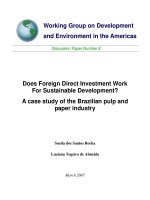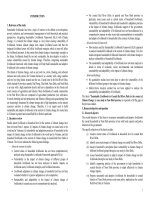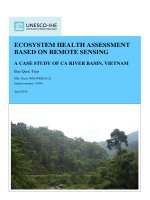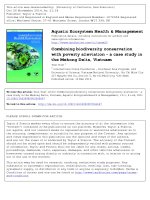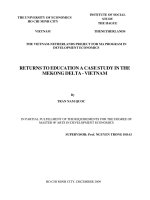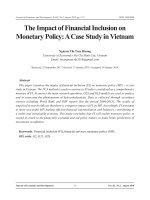Influencing factors on sustainable development a case study in quang tri province, vietnam
Bạn đang xem bản rút gọn của tài liệu. Xem và tải ngay bản đầy đủ của tài liệu tại đây (664.86 KB, 14 trang )
Environ Dev Sustain (2010) 12:103–116
DOI 10.1007/s10668-008-9183-y
Influencing factors on sustainable development:
a case study in Quang Tri province, Vietnam
Le Trinh Hai Ỉ Pham Hoang Hai Ỉ Tran Anh Dung Ỉ Luc Hens
Received: 21 September 2008 / Accepted: 10 December 2008 / Published online: 8 January 2009
Ó Springer Science+Business Media B.V. 2008
Abstract Background Sustainable development (SD) is a common concept. Knowledge
and attitudes are essential in the SD process. This study assesses the knowledge, attitudes,
and practices (KAP) of local people about SD. Aim To study the factors that influence the
understanding of the concept, contents, and indicators of different aspects affecting the
health and environmental issues. Methods A cross-sectional study was carried out from
June to July 2007 among 546 households in the Quang Tri province. Data were gathered on
basis of socio-demographic variables, namely age, gender, education, occupation, income,
and region. Chi square tests and multivariate analysis were performed on the obtained data.
The data were cleaned and analysed using SPSS 15.0 for windows. Results Occupation is
related to knowledge, attitude, or practice. Income is related to knowledge or practice.
Gender related to only attitude. Lastly, region is related to attitude or practice. The proportion of wrong understanding about SD is 2.0 times (95% CI: 1.3; 3.1, p \ 0.001) higher
than that of the people who have good understanding about it. The rate of willingness to do
any related SD programmes of the people who understanding is 2.1 times (95% CI: 1.4;
Readers should send their comments on this paper to: within 3 months of publication
of this issue.
L. T. Hai Á P. H. Hai
Institute of Geography, Vietnamese Academy of Science and Technology, 18 Hoang Quoc Viet,
Cau Giay, Hanoi, Vietnam
e-mail:
P. H. Hai
e-mail:
T. A. Dung
General Department of Preventive Medicine and Environmental Health, Ministry of Health, 138A
Giang Vo, Ba Dinh, Hanoi, Vietnam
e-mail:
L. Hens (&)
Human Ecology Department, Faculty of Medicine and Pharmacy, Free University of Brussels,
Laarbeeklaan 103, 1090 Brussels, Belgium
e-mail:
123
104
L. T. Hai et al.
3.2, p \ 0.001) higher than that of the people who have bad one. Conclusions This study
shows that knowledge on sustainability of the local communities is low. Occupation and
income influence understanding of SD more than region, age, gender, and education. Most
of the local people who do not understand SD in general, do not want to participate or act
in SD programmes.
Keywords Sustainable development Á Knowledge Á Attitude Á Practice Á
Age Á Gender Á Education Á Occupation Á Income Á Quang Tri Á Vietnam
1 Introduction
Sustainable development (SD) is a universal and multi-layered concept. It is not only of
considerable concern at the national, regional, and local policy level but also at household
and individual levels that are most close to people. Therefore, studies on environmental,
social, and economic aspects at provincial and national levels were carried out in Vietnam
since the early 1990s.
The dimensions of SD are summarised in Fig. 1. The figure explicitly refers to economic growth, science, technology and health, education, multinational companies, trade,
war, natural disasters, pollution, and poverty. Putting people at the centre of development
is important for SD as a local initiative model empowers people in a community to discuss
and derive actions and policies at the community level involving business, government,
neighbourhoods, and villages in a way that is interconnected with community functions
(Nath et al. 1998). Personal sustainability and local communities are important factors in
SD because it affects human life in today’s world and shall continue to affect in the future.
The direction of development, beyond one’s interests and towards service, needs to
become more widely considered and accepted and this is an area where a person can take
action (within that person’s network of meaningful relationships), so that he/she can make
a personal contribution to sustainability and society (Hay 2006).
Community-based management is a central element of co-management (Pomeroy and
Rivera-Guieb 2005). Community-based resources management as an approach emphasises
a community’s capability, responsibility, and accountability with regards to managing
resources. It is inherently evolutionary, participatory, and local-specific and considers the
technical, social, cultural, economic, political, and environmental factors impinging upon
the community (Sajise 1995). Nevertheless, research on SD at household, individual, and
Fig. 1 Dimensions of SD
(Ahmed and Stein 2004)
Reviving Economic Growth
Human
Needs
Poverty
Reduction
INDIVIDUAL
GOVERMENT
NGO’s
COMMUNITIES
HOUSEHOLDS
Technology
Management
123
FIRMS
Resources
Sustainable Population Levels
Conservation
Influencing factors on sustainable development
105
community levels (e.g., health care and environmental programmes) are limited or nonexistent, particularly for developing countries.
Quang Tri is a coastal province in the centre of Vietnam. The province has 2 towns and
8 districts. In 2005, 630,000 people lived in Quang Tri (Quang Tri Statistical Office 2007).
Quang Tri is also one of the poorest provinces in Vietnam with a GDP per person of less
than 250 $US per year in 2005 (DoNRE 2007). Research on SD in this province addresses
the issue in general terms, namely understanding, indicators, and performing SD. The
awareness in the communities on SD is low because of poor education levels, poverty, war,
and policy formation. The education level is very low, particularly in the Huong Hoa and
Dakrong districts (GTZ 2004).
In spite of this limited education, local communities were able to contribute new ideas
and information in the decision-making process (Sheate 1994; Petts 1999; Bisset 2000). In
Nigeria, United Nations Economic Commission for Europe (UNECE) (1998) recognised
that in the field of the environment, improved access to information and public participation and decision-making enhances the quality and the implementation of decisions. It
not only contributes to public awareness of environmental issues but also gives the public
an opportunity to express its concerns and enables public authorities to take due account of
such concerns. However, local participation in the decision-making process is low generally especially in developing countries. Another study showed that only one-third of the
participants were interested in the content of a forestry programme (Salam et al. 2005).
The factors that influence the understanding of SD, sustainable development indicators
(SDIs) and implementation of environmental programmes by the local communities are
addressed in this study as Social mobilisation at local levels needs to be backed by
mobilisation around policy issues that require national and even international resolution. A
global capitalism requires a global approach to the environmental question (Friedmann
1990). Nevertheless, the province lacks the adequate infrastructure and policies on SD.
Consultations with local authorities and people on the understanding and participation in
SD in the case studies are closely related because most people are not fully aware of the
government’s support policies (GTZ 2004).
This study relies on a Knowledge Attitude and Practice (KAP) model, which tries to
understand the relationship of factors and SD. A KAP survey has a problem-solving
orientation and operates at the micro-level (GTZ 2006).
The main objective of this study is to study the factors that influence the understanding
of the concept, contents indicators of SD for the aspects health and environment. The study
is done in the province of Quang Tri and puts specific emphasis on the Trieu Phong, Dong
Ha, and Huong Hoa districts. The study thus analyses the influence of demographic
characteristics (age, gender, education, occupation, and income as key factor informants)
and KAP of the local people about SD.
2 Methods
Three areas in the Quang Tri province were selected for the purpose of this study, one
coastal zone (Trieu Phong district), one central region (Dong Ha town), and lastly a
mountain area (Huong Hoa district). In each district, one commune was selected randomly
for the survey. The study collected information profiles and the knowledge of the interviewees on health care and environment. Initially, a pre-test with 50 households was
conducted which indicated that awareness on SD in the local communities was low (15%
of the total population).
123
106
L. T. Hai et al.
A cross-sectional community based study was conducted during the period of June to
July 2007 where participants ranged between 16 and 75 years. A random digit table was
used to select the first household in a village. Thereafter, a ‘‘door to door’’ strategy was
applied to select the next household until enough households in each district were included.
In each district, 182 households were conducted. If a village did not have enough
households, the investigators extended the sample size with households from a neighbouring village. In each household, one representative spokesperson was interviewed to
collect information on the composition of the family and their comprehension of SD,
indicators, and their performance (Annex 1 and Fig. 2). The completed questionnaires
were manually checked before the results were transferred to the computer. The explanatory variables entail:
• Knowledge includes understanding the SD concept, (the SD concept was divided into 2
groups of knowing less than 5 issues and 5 to 9 issues), and the content of SD
(involving 2 groups of less than 5 and from 5 to 16 indicators).
• Attitude: willingness to participate in SD programmes.
• Practice: participation in programmes on health care and/or environment.
The sum of the scores for the above three aspects for those who have the knowledge
about SD including the ones who know the concept and the ones who can identify the
content and indicators ranging from 0 to 26 points are divided as follows:
• Not accepted indicates who scored from 0 to 12 points.
• Accepted indicates who scored from 13 to 26 points.
Pearson’s chi square-tests were used to compare the variables between factors and
events. Logistic regressions using the forward stepwise method allowed us to determine the
relationship between the factors. The Statistical Package for Social Sciences (SPSS for
Windows, release 15.0) was used for this purpose. The 95% confidence intervals were
derived for each variable coefficient. A p-value of 0.05 was considered statistically
significant.
3 Results and discussion
3.1 Knowledge, attitude, and practice of the local people about SD
The results of the answers to the questions addressing the understanding and meaning of
indicators for SD are shown in Table 1 and Annex 1:
• On the basis of the knowledge about the SD concept, different answers were obtained
according to age, education, occupation, and income (p = 0.007, 0.008, and \0.001,
respectively). The ones who do not know about SD turns out to be 3–4 times than the
ones who know about it (e.g. Yes: 31 people and No: 144 people was the answer in the
farmers group).
• On the content of SD (less than 5 or 5–9 issues), people reacted in a different way based
on the factors of education, occupation, and income (p B 0.001). Approximately, 35%
people knew the concept of SD. However, 60% were able to grasp the meaning. One of
the possible reasons for this might be that the issues of SD like the use of safe water,
clean air, access to health care, etc. relate closer to their way of life.
123
Influencing factors on sustainable development
Age
107
Gender
Male vs. Female
16-24 vs. 25-75 years old
0.6
Region
Trader and civil servant
vs. farmer
-0.6
1.6
-1.1
2.5
1.3
-1.0
1.2
Huong Hoa
vs. Trieu Phong
Government official and
teacher vs. farmer
0.6
Dong Ha
vs. Trieu Phong
Occupation
-0.4
-1.2
-2.3
< 2251 vs. 2251-4500
$US/household/year
Tertiary/University vs.
not Tertiary/University
Income
Education
The factor influence
SD:
Sustainable development
The group influence
Knowledge:
To know SD in general
The negative relation
Attitude:
Want to participate in the relative programme
The positive relation
Practice:
Doing any relative programmes
Fig. 2 Path diagram of the factors influencing SD
• On the indicators, occupation (p \ 0.001), income (p = 0.006), and region (p \ 0.001)
differ significantly. Nevertheless, people who know more indicators (from 5 to 18) are
lower than those who know only from zero to five indicators.
Knowledge of the local communities about SD is low. Only about 15% of the total
population in the pre-test indicated that they know about SD. A similar study in the Cat Ba
district that belongs to Hai Phong City in northern Vietnam shows that less than 20% of the
123
108
L. T. Hai et al.
Table 1 Understanding of SD in generala
Factors
Groups
No
p-value
Yes
n
n
%
%
The concept
Age
Education
Occupation
16–25 years old
82
65.1
44
34.9
25–75 years old
324
77.1
96
22.9
78
65.0
42
35.0
Not tertiary/university
328
77.0
98
33.0
Farmer
144
82.3
31
17.7
Trader
179
75.2
59
24.8
Tertiary/university
83
62.4
50
37.6
244
69.9
105
30.1
93
90.4
10
9.6
Government official and teacher
Income
\2,251 $US/household/year
2,251–4,500 $US/household/year
\5 issues
n
n
0.008
\0.001
\0.001
p-value
5–9 issues
%
0.007
%
The contents
Education
Occupation
27
22.5
93
77.5
210
49.3
216
50.7
Tertiary/university
Not tertiary/university
Farmer
94
53.7
81
46.3
Trader
116
48.7
122
51.3
27
20.3
106
79.7
171
49.0
178
51.0
31
29.8
73
70.2
Government official and teacher
Income
\2,251 $US/household/year
2,251–4,500 $US/household/year
\5 indicators
5–18 indicators
n
%
n
%
Farmer
152
86.9
23
13.1
Trader
206
86.6
32
13.4
\0.001
\0.001
0.001
p-value
The indicators
Occupation
94
70.7
39
29.3
273
78.2
76
21.8
94
90.4
10
9.6
Trieu Phong
135
74.2
47
25.8
Dong Ha
172
94.5
10
5.5
Huong Hoa
145
79.7
37
20.3
Government official and teacher
Income
\2,251 $US/household/year
2,251–4,500 $US/household/year
Region
a
\0.001
0.006
\0.001
Only the factors are significantly different
people living near the Cat Ba National Park know about biodiversity conservation and its
related laws and regulations. In particular, the number of Cat Ba people who were not
aware of the Different laws are as follows: Environmental Protection Laws (54.4%), the
fisheries law (81.1%), regulations on the protection of natural resources in Cat Ba (51.1%),
and regulations on environmental protection in Cat Ba and Hai Phong (88.9%) (Hieu
123
Influencing factors on sustainable development
109
2005). Participation and willingness to participate in SD programmes are shown in Table 2
and Annex 2:
• The willingness to participate in SD programmes differs on the basis of education,
occupation, income, and region (p B 0.001). Few people from the Dong Ha town
(46.7%) and the Huong Hoa district (31.3%) indicate that they are not willing to
participate in health and environmental programmes. In the Trieu Phong district,
however, people are prepared to be involved. An interpretation is possibly that poor
people have less access to information and communication about these programmes;
• The number of people responding about non-participation in a programme on health
care and/or environment also differs by age, income, and region (p B 0.001). Most of
them did not participate in any SD programme because they do not see harnessing any
benefits from it. This attitude conforms to the findings that, social impacts and the
distribution of benefits were not taken into account sufficiently when projects were first
proposed (Mirghani and Savenije 1995). This may be the result of lack of coordination
between the public, NGOs, and authorities.
More than half of the people do not want to participate in SD programmes and poverty,
lack of information and education are the main barriers in the success of SD. Poverty has
declined on average by 2% per year (GTZ 2004), but this has had no demonstrable impact
on the parameters measured in this study and this fact is applicable for the whole of
Vietnam in general where people do not really care about the issues of SD. Projects will be
more fruitful if we insist upon both capital cost contribution and a more active voice for
Table 2 Participation and willingness to participate in SD programmesa
No
n
p-value
Yes
%
n
%
Are you willing to participate in programmes of health care and/or environment
Education
Tertiary/university
Not tertiary/university
Occupation
Region
24.2
91
75.8
65.5
147
34.5
Farmer
128
73.1
47
26.9
Trader
144
60.5
94
39.5
36
27.1
97
72.9
206
59.0
143
41.0
2,251–4,500 $US/household/year
42
40.4
62
59.6
Trieu Phong
86
47.3
96
52.7
Dong Ha
97
53.3
85
46.7
125
68.7
57
31.3
Government official and teacher
Income
29
279
\2,251 $US/household/year
Huong Hoa
\0.001
\0.001
0.001
\0.001
Did you participate in a programme on health care and/or environment
Age
Income
16–25 years old
70
55.6
56
44.4
25–75 years old
299
71.2
121
28.8
\2,251 $US/household/year
217
62.2
132
37.8
94
90.4
10
9.6
2,251–4,500 $US/household/year
Region
a
Trieu Phong
103
56.6
79
43.4
Dong Ha
129
70.9
53
29.1
Huong Hoa
137
75.3
45
24.7
\0.001
\0.001
\0.001
Only the factors are significantly different
123
110
L. T. Hai et al.
rural (Propoky 2005). We should invest more in technology and finance, knowledge and
performance on SD, particularly for farmers, the poor, and for the people in the remote
areas.
On the other hand, the interviewees passively participate in environmental activities. As
the study in the Cat Ba National Park indicates that the participation of the local people in
conservation is still very limited. Currently, the local people in Cat Ba have just passively
participated in conservation activities. Most of them regard conservation projects as
opportunities to get ‘‘conservation jobs’’ to improve their livelihood. They still need to be
actively involved in conservation as some of the projects have produced good results and
increased the knowledge for a part of the population (Hieu 2005).
Figure 2 and Annex 3, furthermore by using a logistic regression model, show how the
groups (on the basis of age, gender, occupation, etc.) relate with the events:
• Knowledge (r2 = 0.273) is 1.2 times (95% CI: 0.1; 1.0) higher among the higher
income group as compared to the lower income group (p \ 0.001). The government
official and teachers understand the content of SD 1.9 times (95% CI: 3.3; 13.2) better
than the farmer (p = 0.049). The content of SD is understood 1.3 times better by the
people of Huong Hoa district than the Trieu Phong district. These statistics can be
explained by the fact that the higher income groups and the officials have more access
to education, communication, and participation. This means that an improvement in
income level, in particular through economic development, results in an increased SD
awareness.
• Attitude (r2 = 0.268) differs according to gender, occupations, and regions. Women
like to participate less (0.4 times) in the health and environmental programmes than
man. The Government official and teachers are 1.2 times (95% CI: 6.9; 22.5) more
aware than the farmer. One of the main reasons is that the government officials work in
the administration, the union, or the official organisation. Therefore, they come more
frequently in contact with the SD concept, whereas farmers are poor and live in
agricultural and remote areas.
• Practice (r2 = 0.178): In general, two-thirds of the people interviewed have not done
any SD programmes. The results show that it differs according to income, occupation,
and region. The lower income group, for example, is 2.3 times (95% CI: 0.1; 0,2) less
participative than the higher income group. Possible reasons are poverty and low
education. This echoes with the GTZ survey (2004) which showed that typical features
of poor households in Quang Tri include lack of production tools and business
experiences, vulnerability to sickness, large families, household members with
disabilities, and single households or beneficiaries of social policies. Most of them
are poorly educated and work mainly in agriculture where productivity is low and
unstable. Poverty alleviation and SD are the most important objectives of participatory
sustainability and recognising participants’ knowledge is essential while forming the
SD strategy.
3.2 Relationship among knowledge, attitude, and practice
The people who are not accepted (59.2%) in understanding SD in general and do not want
to participate in SD programmes are 2.0 times higher than who are accepted (29.4%) (95%
CI: 1.3; 3.1 and p \ 0.001) (Table 3). In not doing any related SD programmes, the people
who are not accepted (71.1%) in understanding SD in general are 2.1 times higher than
those who are accepted (33.3) (95% CI: 1.4; 3.2 and p \ 0.001).
123
Want to participate
Total
Doing any related
Total
SD programmes
Knowledge of SD in general
Total
No (%)
Yes (%)
Not accepted
293 (59.2)
202 (40.8)
Accepted
15 (29.4)
36 (70.6)
308 (56.4)
OR = 2.013
No (%)
Yes (%)
495 (100%)
352 (71.1)
143 (28.9)
51 (100%)
17 (33.3)
34 (66.7)
51 (100%)
238 (43.6)
546 (100%)
369 (67.7)
177 (32.4)
546 (100%)
95% CI
p \ 0.001
OR = 2.133
95% CI
p \ 0.001
(1.3; 3.1)
Influencing factors on sustainable development
Table 3 Relationship between knowledge of SD and willingness to joint SD programmes
495 (100%)
(1.4; 3.2)
111
123
112
L. T. Hai et al.
Thus, the interviewers who are not accepted in understanding SD in general would
mostly not want to participate and do any related SD programmes. The crux of the
problems needs to be addressed. The gap in the society through various programmes can
generate long-term benefits. This means that the local community needs training and
education for understanding SD. To realise a provincial policy on SD, training and education are essential so that the inhabitants can join the SD programmes. Such a strategy
would not only develop local capacities for SD, but it will also help to curb inefficient
provincial policies and practices. Enhanced environmental education will foster the
understanding of the environment and SD and further encourage civil awareness of and
participation in decisions affecting the environment and SD (United Nations Economic
Commission for Europe (UNECE) 1998).
The local people should be encouraged to participate in commune activities, particularly
in environmental networking, in health programmes, and in initiatives to improve their
social situation. The communities need more reciprocity and trust to flourish (Maser 1998;
Hay 1998).
To address these problems in the long-run and to face future SD challenges, a more
comprehensive approach is necessary. Personal development should be an essential part of
it because the vast majority of people have become passive observers, and a few people are
taking decisions for everyone else and is the primary reason affecting the environment
(Agarwal and Narain 1990). Connecting people and places at the margins of the economy
to a vision of environmentally friendly development, which improves quality of life for all
is a challenge (Carley and Christie 2000). The more the people involved in the case study
understand and participate in the programmes, the better the project outcomes can be.
4 Conclusions
Existing projects on SD do not sufficiently impact the public because with regard to
participation and empowerment, the decentralisation and delegation of powers are not
comprehensive due to the lack of financial and budget decentralisation (GTZ 2004).
The results of this study demonstrate an inverse relationship between SD and the factors
at the community level. Different types of people have a different understanding about SD.
The type of knowledge people have, is related to their age, gender, education, occupation,
social status, and history (International Institute of Rural Reconstruction 1998). In this
analysis, we studied how the factors of age, gender, education, occupation, and income
affect SD.
In general, only 15% of the population in Quang Tri associates SD with content.
Occupation and income affect this understanding but do not influence practice. Farmers
associate SD 1.2–1.7 less with a particular content than the government officials and
teachers. The higher income group understands SD 1.4–2.0 times better than the lower
income group. It is not surprising that the number of people who have never done any
programmes related to health and/or environment do not want to participate in the SD
projects and are more than 2–3 times, statistically, than the ones who have done such
programmes before. These differences can be explained on the basis of poverty, education,
war, and natural disasters. These are related with the provincial policy and the limited
impact of the authorities on the districts and the communities. Most people who do not
understand SD in general, do not want to participate in SD programmes with OR = 2.013
and 2.133, 95% CI (1.3; 3.1 and 1.4; 3.2), and p \ 0.001, respectively. The age and
education groups do not relate to any events of the KAP.
123
Influencing factors on sustainable development
113
Factors that are associated with SD should be taken into account when taking people
through the SD process with emphasis on the poor, farmer, and female. The province, in
fact, has no strategy on sustainable development (PSSD). The PSSD process acts as a
poverty reduction strategy. The study shows the state of awareness of the local people
about the concept of SD in general, understanding the content of SD, and performance on
SD programmes. This study is limited to Quang Tri and the aspects of health and
environment.
Acknowledgements We would like to thank Prof. Dr. Leonard Kaufman (Department of Medical Statistics, Free University of Brussels, Belgium), Mrs. Nguyen Quynh Anh (Hanoi School of Public Health),
MD. Hoang Nam Thai (Family Health International, Vietnam Office), and MD. Hoang Minh Duc (National
Institute of Hygiene and Epidemiology) for their helpful comments and Miss. Rachel Sandra Stephen
Waghchoure (World Wide Funds, Pakistan) for her English review of this paper.
Annex
Annex 1: The list of explanatory variables
Demographic information
•
•
•
•
•
Age: 16–24 years old = 1, 25–75 years old = 2;
Gender: male = 1, female = 2;
Education: tertiary/university = 1, not tertiary/university = 2;
Occupation: farmer = 1, trader = 2, government official and teacher = 3;
Income ($US per year per house): \2,251 = 1, 2,251–4,500 = 2.
Knowledge: including:
Knowing the concept of SD: No = 0, Yes = 1.
Identifying the content of SD: \5 issues = 0, 5–9 issues = 1 (the sum of the scores for 9
issues: Using safe drinking water (No = 0 or Yes = 1) ? Living within a fresh air area
(No = 0 or Yes = 1) ? Increasing forest land (No = 0 or Yes = 1) ? Access to health care
centre (No = 0 or Yes = 1) ? Pupils go to a school (No = 0 or Yes = 1) ? Employment
(No = 0 or Yes = 1) ? Enough food (No = 0 or Yes = 1) ? High population growth
(No = 0 or Yes = 1) ? Having sanitation (No = 0 or Yes = 1).
Identify SDIs: less than 5 indicators = 0, 5–16 indicators = 1 (the sum of the scores of
16 indicators: Life expectancy at birth (No = 0 or Yes = 1) ? Mortality rate under age
five (No = 0 or Yes = 1) ? Nutritional status of infants (No = 0 or Yes = 1) ? Access
to safe water (No = 0 or Yes = 1) ? Percentage of population with adequate sewage
disposal facilities (No = 0 or Yes = 1) ? Immunisation against infectious childhood
diseases (No = 0 or Yes = 1) ? Contraceptive prevalence rate (No = 0 or
Yes = 1) ? Percentage of population with access to primary health care facilities (No = 0
or Yes = 1) ? Arable land per capita (No = 0 or Yes = 1) ? Soil erosion (No = 0 or
Yes = 1) ? Land use changes (No = 0 or Yes = 1) ? Use of agricultural pesticides
(No = 0 or Yes = 1) ? Air pollutions ? Faecal coliform in freshwater (No = 0 or
Yes = 1) ? Percentage of forest area (No = 0 or Yes = 1) ? Abundance of selected key
species).
Attitude: want to participate in the programmes, No = 0, Yes = 1.
Practice: doing relative programmes of health care or/and environment, No = 0,
Yes = 1.
123
114
L. T. Hai et al.
Annex 2: To understand, perform, and participate in SDa
The concept
Factors
No
Groups
Gender
Male
Female
Region
Trieu Phong
Dong Ha
Huong Hoa
N
213
193
145
134
127
The contents
Yes
%
74.2
74.5
n
74
66
%
25.8
25.5
79.7
73.6
69.8
37
48
55
20.3
26.4
30.2
p-value
0.936
0.093
16-25 years old
25-75 years old
< 5 issues
N
%
48
38.1
189
45.0
5-9 issues
n
%
78
61.9
231
55.0
Gender
Male
Female
122
115
42.5
44.4
165
144
57.5
55.6
0.656
Region
Trieu Phong
Dong Ha
Huong Hoa
47.3
39.6
43.4
96
110
103
52.7
60.4
56.6
0.334
Age
Age
Gender
86
72
79
The indicators
16-25 years old
25-75 years old
< 5 indicators
N
%
109
86.5
343
81.7
Male
Female
238
214
82.6
82.6
5-18 indicators
n
%
17
13.5
77
18.3
49
45
17.1
17.4
p-value
0.170
p-value
0.207
0.926
Tertiary/University
93
77.5
27
22.5
0.083
Not Tertiary/University
359
84.3
67
15.7
Are you willing to participate in programmes of health care and/or
environment
Education
No
Age
16-25 years old
25-75 years old
Yes
%
57.1
56.2
N
72
236
%
42.9
43.8
n
54
184
p-value
0.850
Male
161
56.1
126
43.9
0.877
Female
147
56.8
112
43.2
Did you participate in a programmes on health care and/or environment
Gender
No
p-value
Male
Female
%
66.9
68.3
n
95
82
%
33.1
31.7
Education
Tertiary/University
Not Tertiary/University
82
287
68.3
67.4
38
139
31.7
32.6
0.842
Occupation
Farmer
Trader
Government official and Teacher
126
155
88
72.0
65.1
66.2
49
83
45
28.0
34.9
33.8
0.311
Gender
a
Yes
N
192
177
Only the factors are not significantly different
123
0.719
Influencing factors on sustainable development
115
Annex 3: Logistic regression analysis
Knowledge of the local people
(To know the concept of SD (r2 = 0.133a and 0.273b))
Regression
95%CI
coefficient
Occupation (Government official and Teacher vs. Farmer)
1.2
3.3; 13.2
Income (< 2251 vs. 2251-4500)
-1.2
0.1; 1.0
Region (Huong Hoa district vs. Trieu Phong district)
1.3
1.8; 8.0
p-value
< 0.001
0.049
0.001
Attitude of the local people (Want to participate in the health care and
environmental programmes (r2 = 0.200a and 0.268b))
Gender (Male vs. Female)
-0.4
0.4; 1.0
0.050
Occupation (Trader vs. Farmer)
0.6
1.1; 2.9
0.020
Occupation (Government official and Teacher vs. Farmer)
2.5
6.9; 22.5
< 0.001
Region (Huong Hoa district vs. Trieu Phong district)
-1.1
0.2; 0.5
< 0.001
Practice of the local people (Have done any relative programmes to
environment and health care (r2 = 0.126a and 0.178b))
Occupation (Trader vs. Farmer)
0.6
1.1; 3.0
0.021
Occupation (Government official and Teacher vs. Farmer)
1.2
1.9; 6.0
< 0.001
Income (< 2251 vs. 2251-4500)
-2.3
0.1; 0.2
< 0.001
Region (Dong Ha town vs. Trieu Phong district)
-0.6
0.3; 1.0
0.035
Region (Huong Hoa district vs. Trieu Phong district)
-1.0
0.2; 0.6
< 0.001
a
Cox and Snell R square
b
Nagelkerke R square
References
Agarwal, A., & Narain, S. (1990). Towards green villages: A strategy for environmentally south and
participatory rural development. New Delhi, India: Centre for Science and Environment.
Ahmed, A., & Stein, J. A. (2004). ‘‘Science, technology and sustainable development: A world view’’,
World review of Science. Technology and Sustainable Development, 1(1), 5–24. doi:10.1504/
WRSTSD.2004.004852.
Bisset, R. (2000). Methods of consultation and public participation (Chapter 9). In N. Lee & C. George
(Eds.), Environmental assessment in developing and transitional countries. Chichester: Wiley.
Carley, M., & Christie, I. (2000). Managing sustainable development, 2nd ed. Earthscan Publications Ltd.,
ISBN 1 85383 440 8 (pb) and 1 85383 445 9 (hb).
DoNRE. (2007). Environmental situation of Quang Tri province in 2006. Vietnam: DoNRE.
Friedmann, J. (1990). Policy, planning and the environment. Journal of the American Planning Association,
56, 334–346.
GTZ. (2004). Quang Tri participatory poverty assessment (pp. 3–5). Hanoi, Vietnam: GTZ.
GTZ. (2006). Strategic communication for sustainable development: A conceptual overview (pp. 38–39).
Eschborn, Germany: GTZ.
Hay, R. (1998). A rooted sense of place in cross-cultural perspective. The Canadian Geographer, 42(3),
245–266.
Hay, R. (2006). Becoming ecosynchronous, Part 2. Achieving sustainable development via person development. Sustainable development, 14(1), 1–15. doi:10.1002/sd.257.
Hieu, V. V. (2005). Participation of local communities in biodiversity conservation: A case study in Cat Ba
National Park, Vietnam. Master thesis, Human ecology Department, Free University Brussels (VUB),
Belgium.
International Institute of Rural Reconstruction. (1998). Participatory methods in community-based coastal
resource management, 3 volumes. Silang, Cavite, Philippines. Available on the website http://www.
idrc.ca/en/ev-93108-201-1-DO_TOPIC.html. Accessed 24 Jan 2008.
Maser, C. (1998). True community is founded on a sense of place, history and trust. The Trumpeter, 15, 1–5.
Mirghani, M. M. O., & Savenije, H. H. G. (1995). Incorporation of people’s participation in planning and
implementation of water resources projects. Physics and Chemistry of the Earth, 20(3–4), 229–236.
doi:10.1016/0079-1946(95)00033-X.
123
116
L. T. Hai et al.
Nath, B., Hens, L., & Devuyst, D. (1998). Sustainable development (2nd ed.). Brussels, Belgium: VUB
Press.
Petts, J. (Ed.) (1999). Handbook of environmental impact assessment Volume 1: Environmental impact
assessment: Process, methods and potential. Oxford: Blackwell.
Pomeroy, R. S., & Rivera-Guieb, R. (2005). Fishery co-management: A practical handbook. CABI and
IDRC, ISBN 0-85199-088-6 and e-ISBN 1-55250-184-1.
Accessed 5 Jan 2008.
Propoky, L. S. (2005). The relationship between participation and project outcomes: Evidence from rural
water supply project in India. Printed in Great Britain. World Development, 33(11), 1801–1819. doi:
10.1016/j.worlddev.2005.07.002.
Quang Tri Statistical Office. (2007). Statistic yearbook in 2006. Quang Tri, Vietnam: Quang Tri Statistical
Office.
Sajise, P. (1995). Community-based resource management in the Philippines: Perspectives and experiences.
A paper presented at the Fisheries Co-management workshop, North Sea Center, 29–31 May,
Hirtshals, Denmark. Accessed 5 Jan 2008.
Salam, M. A., Noguchi, T., & Moike, M. (2005). Factors influencing the sustained participation of farmers
in participatory forestry: A case study in central Sal forests in Bangladesh. Journal of Environmental
Management, 74, 43–51. doi:10.1016/j.jenvman.2004.08.007.
Sheate, W. R. (1994). Making an impact: A guide to EIA law and policy. London: Cameron May.
United Nations Economic Commission for Europe (UNECE). (1998). Convention on access to information,
public participation in decision-making and access to justice in environmental matters. http://www.
unece.org/env/pp/documents/cep43e.pdf. Accessed 5 Feb 2008.
123
